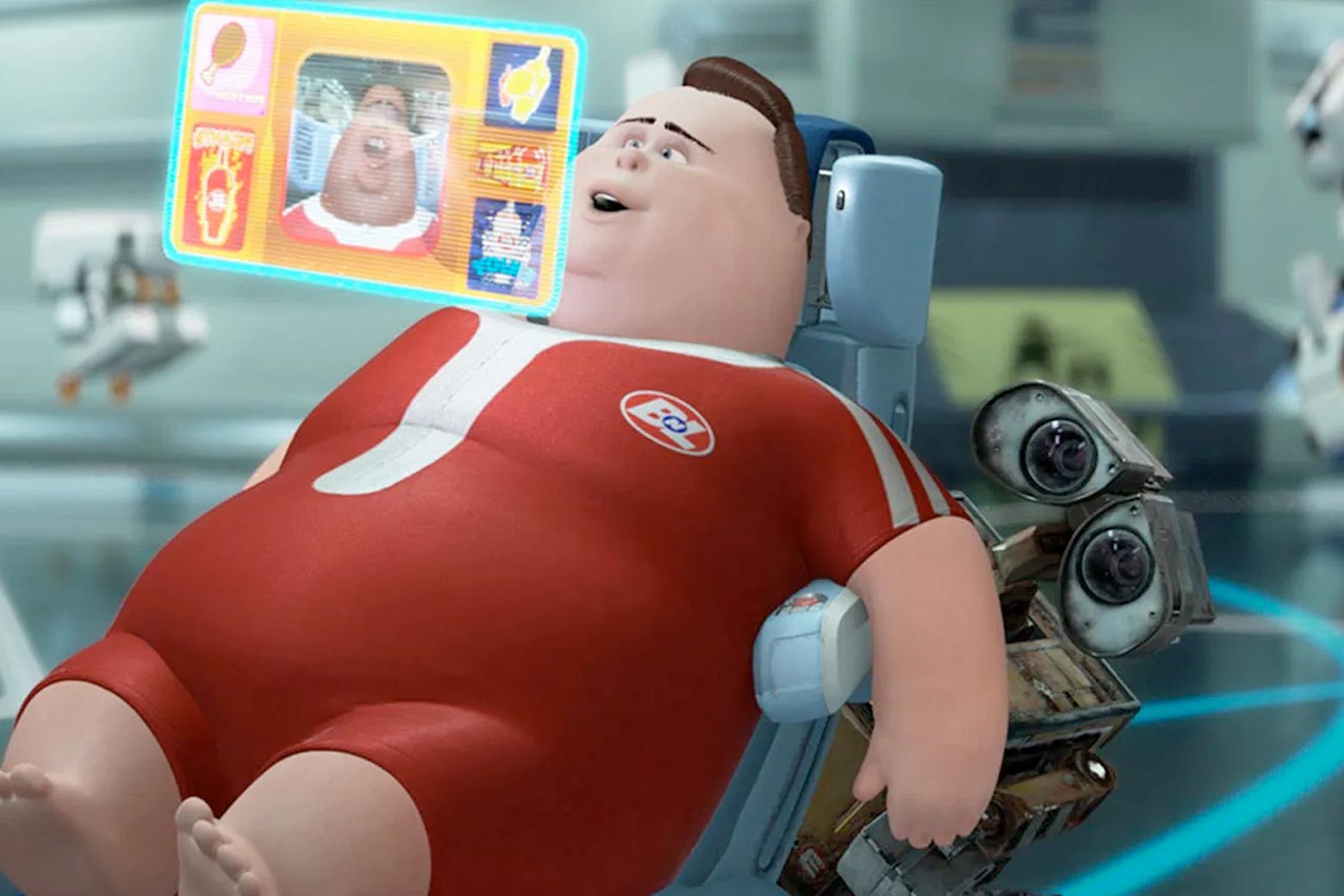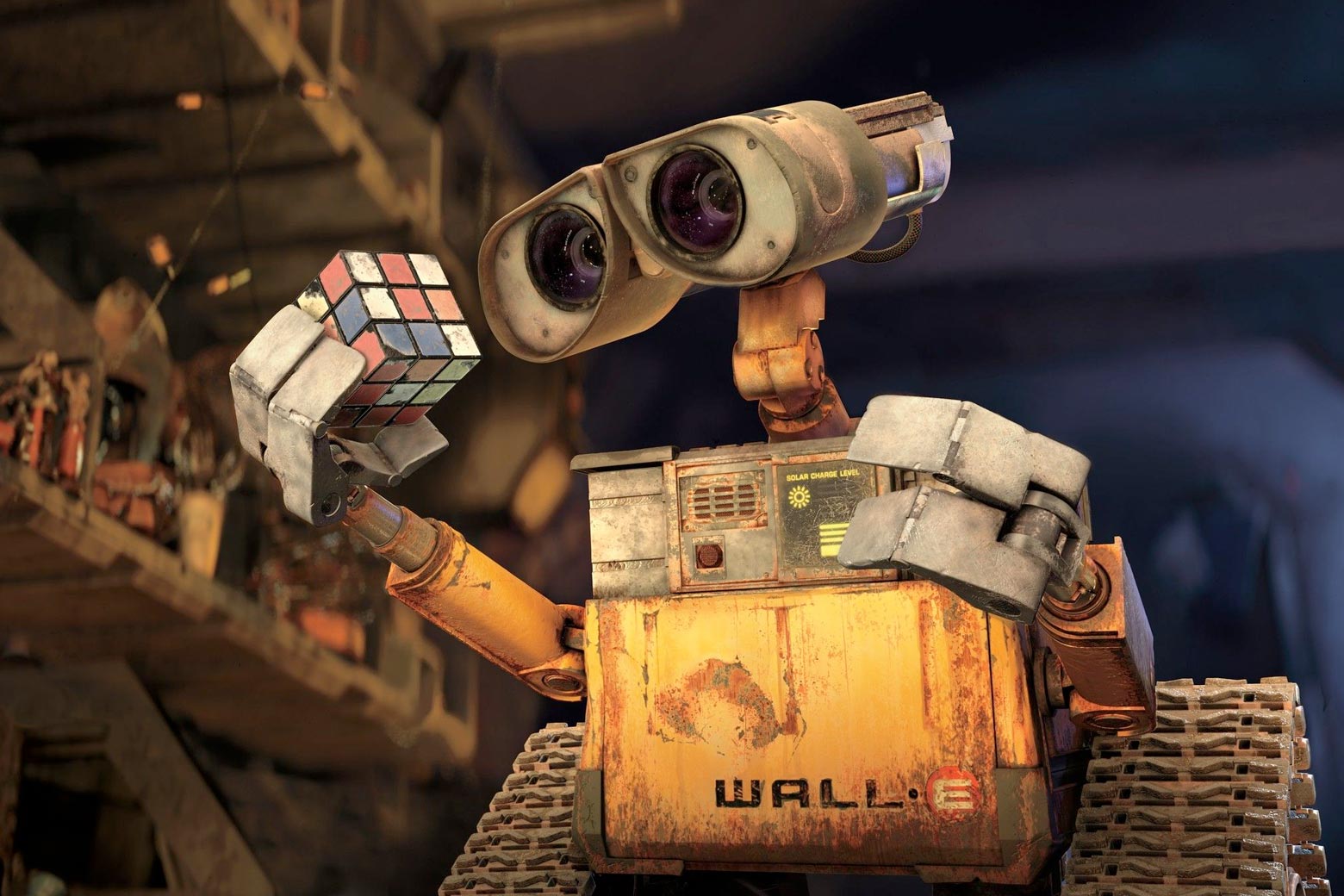There Will Be Blood begins nearly in silence. Its stunning opening 20 minutes follow a solitary figure as he struggles through an American wasteland, digging, bleeding, building. In its howling quiet, its violent yet graceful choreography, the film presents an iconic image of the ravages of greed, the inextricable link between the mythology of American exceptionalism and the circuits of capital—a lone tragic hero representing the creation of the American dream as well as its inevitable apocalyptic end. The film stages this brutal ballet before bringing it to crisis with the appearance of another, the possibility of love, the hope, however remote, of a future. Paul Thomas Anderson’s 2007 epic begins with one of cinema’s greatest depictions of the desire and despair at the heart of American capitalism.
But then, so does WALL-E.
Nearly everything about the knockout opening of Anderson’s masterpiece is also true of Pixar’s masterpiece, released in theaters the following year, and, as of this week, the first film from the animation studio to be inducted into the vaunted Criterion Collection. That it would be this particular film to be the first recognized by the guardians of the Criterion Closet makes a certain amount of sense—given that WALL-E, with its gritty aesthetic, nominal anti-consumerist message, and classical Hollywood nostalgia has always been Film Twitter’s favorite Pixar picture. But, outside of being a laudable artistic achievement, the film is also a prophecy, and it’s one that, 14 years later, both has and hasn’t come true. While There Will Be Blood is a grim reckoning with the U.S.’s desert origins, WALL-E is a prescient vision of its desert future.
Instead of dastardly oil man Daniel Plainview, WALL-E’s spectacular opening follows a lovable little robot tasked with cleaning up a landscape abused and abandoned by its inhabitants. Sapped, presumably, of all its resources and clothed in the eternal smog of car exhaust, WALL-E’s Earth is the one we saw Plainview desperate to create. In short, WALL-E tells a story, hundreds of years into the future, of an Earth decimated by climate catastrophe and rendered barren by toxic waste. The Earth has become overrun with trash, much of which appears to be produced by Buy n Large, a multinational corporation whose ads still run on the innumerable screens that still litter the desolate terrestrial cities of the globe. From those ads, we learn that, at some point, humankind left the Earth on luxury aerial cruise ships—powered by Buy n Large—so that an army of cute little trash robots could be left to quickly and methodically dispose of the waste and render the planet safe for return.
Eventually, we realize that this exodus occurred in the distant past. Earth remains ruined, and only one of the trash robots—our hero, WALL-E—remains functional. The ancestors of those emigrant humans now live in exile in deep space, where they’ve evolved to become immobile, screen-obsessed blobs. The plot of WALL-E begins, after that stunning opening set piece, when WALL-E discovers the first new plant to grow on Earth in all that time. In short order, the plant sets off alarm bells, an ultra-advanced A.I. robot pod—named Eva—arrives to collect the specimen for analysis and, unexpectedly, appears to fall in love with WALL-E. The film then shifts back to the cruise ships as WALL-E and Eva fight against Buy n Large’s robotic overlords to bring humankind back to Earth, where it can regain all it has lost and start anew.
WALL-E is a satirical dystopia of a distant future, but as I rewatched the film in 2022, it’s hard not to see how quickly some of its prognostications have become real, even to the point of cliche. When the film hit theaters in 2008, for instance, the first iPhone was only a year old (Pixar employees were given iPhones in the middle of the film’s production before they were even on the market), and yet its screen-time satire feels eerily knowing, even a little too on the nose. Itself a product of Silicon Valley (not to mention Steve Jobs), Pixar, unsurprisingly, would be able to design devices for its exiled humans that look and act a lot like the glassy rectangles that would become ubiquitous over the decade to follow. In imagining a human species so disconnected from its earthly home that it could forget about the desire to return, WALL-E shows us gelatinous humanoids ferried about on hovering wheelchairs, placated into an illusion of social connection by way of screens projected inches in front of their faces. In trying to come up with a device that could essentially disable humanity en masse, Pixar simply invented the iPad.
While director Andrew Stanton and co-writers Peter Docter and Jim Reardon were able to uncannily anticipate a number of specific technological advancements, their response to those future devices is rooted in the same “screen time” moral panic American culture has been dealing with since the 1990s. Screens are a disease, an addiction, even a perversion: American culture’s aversion to them is shot through with fear of drugs, of sexual deviance, even and especially fatphobia. The film sees these futuristic screens as symptoms of a broader problem, and it correctly predicts the way those screens would ultimately be policed and blamed for all manner of other global ills, but what the film can’t seem to see is how insufficient that critique would prove to be. Its technological imagination is seemingly boundless, but its social imagination is humdrum, positively 20th-century. WALL-E is not, in other words, a film that offers eerie premonitions about our future alone; it’s a film that shows us just how predictable our future had always been.

When WALL-E was released, American popular culture was largely in an anticipatory, Al Gore–as–Cassandra period about the eventual ravages of climate change. (An Inconvenient Truth, and its attendant discourse cycles, appeared in 2006.) Activist groups and organizations had never ceased sounding the alarm, but the mainstream media was only in the midst of reawakening to global climate concerns. And news feeds were not yet filled with historic floods and wildfire seasons topping each other every year as they are now. WALL-E’s opaque skies, dust storms, and inhospitable soil, again, feel like a premonition. But so too does its insistence on blaming individual behavior. We certainly understand that WALL-E’s Earth is cloaked in toxic smog from the burning of fossil fuels, but it’s also preoccupied with a narrative that climate disaster could have been averted if only humans would pick up after themselves. The film’s environmentalism tops out at a vociferous hatred of litter.
WALL-E, of course, does have a corporate villain. And it’s a corporate villain that, yet again, the filmmakers had the foresight to imagine. Buy n Large, perhaps more than anything else about the film, has a kind of psychic resonance with our present. I’m not sure that writers in 2022, seeking to skewer Amazon’s “everything store” approach to global hegemony, could do much better than WALL-E did in 2008. The villain of this film is not an energy company or a reckless financial institution or even a malevolent government. It’s a store, a store that has made life so easy for its shoppers that it has allowed humanity to rot from laziness, complacency, stasis. In our timeline, we understand the malevolent imbrication of Amazon, its grotesque labor practices, even Jeff Bezos’ dreams of interstellar escape. But, in WALL-E, Buy n Large is merely a force multiplier for human weakness. They did it to themselves. It’s consumer choices, ultimately, that killed the planet, and consumer choices that can thus save it.
It’s worth noting, of course, that while There Will Be Blood might have the more sophisticated systemic critique out of these two capitalist catastrophes of the late aughts, WALL-E is, strictly speaking, a movie for children. Perhaps it’s too much to demand that a kids cartoon offer a pragmatic solution to the end of the world when it’s already predicting the future with unusual clarity. But WALL-E transcends its genre in multiple ways, and for what it’s worth, it does offer a solution to the end of the world, so returning to it now, it seems worth asking if the solution’s any good.
While WALL-E sees the future keenly, its diagnoses and prescriptions are drawn from a romanticized past that we know for sure did not have the answers to our current calamity. When our little trash robot settles into his trailer to wistfully watch a VHS of Hello, Dolly!, the seeds of a genuinely transformative, even transcendent, critique are planted. Perhaps this film and its Technicolor majesty will teach this robot what humanity is, why it’s worth saving. More than that, this last beacon of American cinema’s long lost Golden Age might spark our heroes to imagine something fundamentally unimaginable in response to the threat of annihilation. But we eventually realize that this moment of seemingly pure cinematic transportation symbolizes something else: a false nostalgia for when times were simpler. As the film goes on, it falls back on narratives that misdirect, misperceive, and just miss the point. WALL-E falls into a heterosexual marriage plot, the film itself falls back on old (discredited) stereotypes about screen time and obesity, and it loses the fine-grained texture with which it began. It tries to climb out of its prophesied dystopia by reinstating all the social and cultural blind spots that led to it in the first place.
Not every film has to stick the landing. The daring of that opening passage, the posthuman romance of two robots learning how to dance with each other bathed in the light of a Hollywood musical, the Chaplinesque grace of WALL-E’s refusal to give up—those things remain and, if I’m being totally honest, are the things I’ve remembered from the film over all those years. WALL-E is not a radical film. It envisions a scarily accurate portrait of the future only to deliver tired talking points and encourage viewers to stop using plastic straws. Put down your phone and pick up a shovel. The product of a multinational corporation, it can’t imagine the vast dissolution and reconception of economies that would be required to prevent its grim landscape from becoming our own. WALL-E, perhaps by design, is not programmed to do that. But, if you have a free 20 minutes, take the screen that’s planted a couple inches away from your face, and watch that little trash robot do his dance at the end of the world, and think about what you wish could come next.
